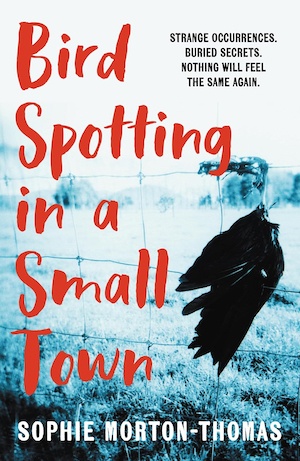
The Norfolk coast, where marsh meets sea, is the perfect habitat for a whole range of bird species. And for people who want to get away from the hustle and bustle of bigger towns, it’s the perfect place to escape to… or to hide. However, the wind feels colder, the shadows seem darker and what you’re hiding from – real or imagined – might find you anyway. In Bird Spotting in a Small Town, Sophie Morton-Thomas takes us to this isolated setting, where loneliness drains the spirits of her characters, while the tension stretches them to breaking point.
Here we meet Fran, owner of a caravan park. It’s mid-winter and she spends her days cleaning empty caravans, looking after her son, Bruno, and waiting for acknowledgement from her husband, Dom. When she has a spare hour or two, she walks the path down towards the sea to look at the birds. She’s even had a hide built by the marsh, but when she finds a terns’ nest elsewhere, she regrets the hide’s location.
Then the Roma travellers arrive and Tad, an older man, fills us in on their story. He’s an outsider, even among the Roma, and worries about his younger brother, Charlie. They’ve moved across the country to the field next to Fran’s holiday caravans to avoid the police at their previous location. Charlie is a murder suspect. The story unfolds in chapters told by Fran and Tad.
Living in one of Fran’s caravans are her sister Ros, brother-in-law Ellis and niece Sadie. Fran and Dom are supporting them as Ellis is a recovering alcoholic who hasn’t been able to hold down a job for a while. They’ve even paid for his rehab. Ros is fragile and Fran is worried that Sadie is neglected, but equally she doesn’t want to intervene too much or make Ros and Ellis feel indebted.
On the other hand, it’s great that Bruno can spend time with his older cousin Sadie. They’re at the same school, and the two mothers and the cousins walk there together each morning. A new teacher has started, who has bright pink hair, stripy leggings, a tattoo or two, and is the subject of some gossip. Ms McConnell is fascinating at first, but soon there are problems between Sadie and her teacher.
As this slow burn family drama starts to glow, things get creepy. Someone has been beheading and dismembering birds. Bruno has found their bodies, and it seems that Sadie might be the culprit. At the same time, the children grow curious about the travellers and start visiting their camp, where they meet Tad and Charlie. Tad senses they’re troubled and that Sadie seems particularly lonely. Charlie, meanwhile, has become interested in the terns’ nest, just like Fran.
About halfway through, the big twist occurs. Ms McConnell, the teacher, and Ellis, both disappear. It’s a jolt for Fran and her family, and the suspicion is that the teacher is dead and that Ellis is the guilty party, which is why he’s run away. The spiral Fran is in seems to accelerate, while Tad observes from a distance and interprets events via the children. Then, a body is discovered…
As a reader, you are totally reliant on Fran and Tad, but one or both of them could be an unreliable narrator. Sophie Morton-Thomas plays this to wonderful effect, particularly with Fran, who generally has more to say. You feel she is the overlooked wife, craving affection and worried that Dom’s approach to child rearing is a little insensitive. Yet there are times when it seems she is pushing Dom away. He doesn’t appreciate the birds the way she does, and birdwatching is what she escapes to, where she feels free and alive, away from their cottage. That terns’ nest becomes a metaphor for something else in the story, as you’ll discover.
Although two people have disappeared and a family is disintegrating, frustratingly little happens – even after the body is discovered. Fran and Tad are of little help; while your mind is searching for answers, they’re focused on other things and their thinking goes off on tangents. You may form a difficult relationship with them, just as their relationships with the other characters are filled with unease. This is deliberate and it’s intrinsic to the story – there’s no perfect route through.
Via the characters and the setting, we find ourselves on the fringe – of society, and perhaps of reality and of sanity. As the story reaches its climax, you’ll gasp in several places when Fran finally accepts a rational explanation for something she has built up and obsessed over. There are some incredible revelations as the story ends. Awful deeds; culprits that will surprise you. Things finally make sense. One of the big reveals is amazing and believable. However, one of the things we discover is too big to have been kept hidden plausibly, which takes a little away from the book’s conclusion.
Still, Bird Spotting in a Small Town is a remarkable feat of storytelling rich with a literary feel – and there’s a second age-old avian metaphor in the story to discover. The setting, atmosphere, characters who see the world through a mirky window pane, strained relationships, deeply troubling events… it’s slow burn psychological crime which warns that buried secrets will come back to hurt you.
Also see A Siege of Bitterns by Steve Burrows.
Verve Books
Print/Kindle
£4.99
CFL Rating: 4 Stars







